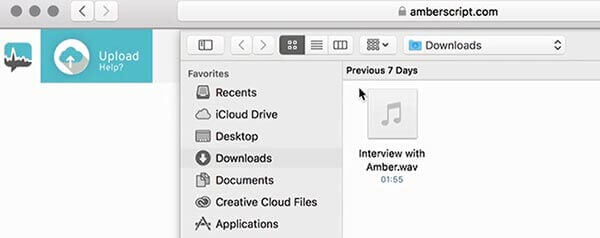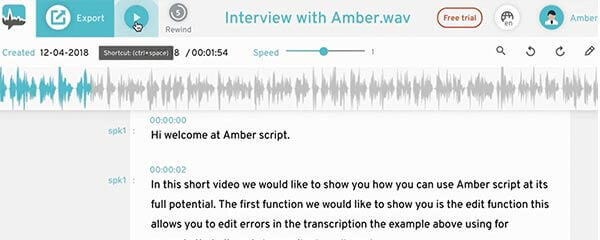How to Transcribe an Interview
Get your transcript in minutes
This article is about transcribing interviews and how to transcribe an interview for academic purposes into a written document that can be attached to your research document.
In the article, we will look at the different methods and techniques that can be used to do transcriptions and also provide some useful information on how to transcribe an interview that university or college students can use when they are transcribing interviews for their bachelors or masters degrees.
How to transcribe an interview using the software in transcribing interviews will also be dealt with when we discuss the different stages of software used in the process of how to transcribe an interview.
How to transcribe an Interview: FAQs
The first step in how to transcribe an interview is to use quality recording equipment to record the interview and to use a quality headset to listen to the recording. A great tip is to practice your typing speed beforehand if you intend to manually transcribe the recording.
A good transcription software program combined with a foot pedal will greatly enhance your transcription speed. Lastly, it is important to work in a quiet work environment where you can concentrate without being disturbed.
The best place transcribing interviews is somewhere quiet where you can work without any interruptions or distractions that can influence the quality of your transcription.
The best time and how to transcripe an interview will entirely depend on yourself, many people wait till they have finished all their interviews or do it in batches. If you are pressed for time it is advisable to transcribe every interview after you have conducted it.
The general rule of thumb is that you should not take longer than four hours to transcribe one hour of audio. This boils down to a ratio of 4:1 which means that you should allocate four times the duration of the recording for transcription time.
The purpose of transcription is to change a voice record into written text, this will enable you to read the text, organize and archive it for later use. The written document makes it easier to use the information for research or study purposes.
A transcript is a detailed written record of an interview or a discussion with a group that is produced after transcribing audio or videotaped record of the interview or discussion.
Verbatim transcription refers to the process where the spoken word is converted into text in such a way that the essence of the message is captured exactly in the way it was spoken. This requires practice, skill and attention to the detail of the recording by the person doing the transcription.
How to transcribe an interview
The choice on how to transcribe an interview will depend on the number of speakers, the content of the recording, different accents used and the tempo of the speech.
There are two ways in which transcribing interviews can be done which will be discussed below:

Manual transcription
Manual transcription can be done by yourself, another option is to outsource it to a professional transcriber. Manual transcription refers to the process where the transcriber sits down and listen to the voice recording of the interview, preferably while using headphones.
The transcriber then turns the audio recording into a written text in accordance with the brief provided or as required by the research project. The transcript can be done as a verbatim transcript, intelligent verbatim transcript or as an edited version of the intelligent verbatim transcript.

Automatic transcription
The automatic transcription of interviews refers to the use of a transcription software that assists the transcriber in the process of converting the audio of the interview into a written text. The development of new software makes this a faster option than manual transcription but mistakes still occur in the transcript from audio or video to text. The advantage is that the user has a software generated text available that can be reviewed, revised, edited and proofread to produce a near perfect text in much less time. The advantage is that a text copy uses much less memory than an audio recording and can be print out as a document.
How to transcribe an interview for your thesis
A bachelor or master thesis refers to a research proposal or academic study in which a student’s theories and findings are contained in. The thesis must contain factual evidence which will support the findings and theories. In many instances, this evidence consists of interviews, audio or video recordings, and lectures given at seminars. This evidence must be transcribed into text that can be incorporated into a document, this process can place a huge demand on the available time of the student.
Although it is very easy to make a high-quality video or audio recordings with the available technology for academic purposes, transcripts will still be the norm where interviews or recordings take place as part of the study. It is also easier to use text documents when doing analysis or comparisons.
Whilst there are huge advantages with the development of software that can assist us in this task, the human touch is still needed when doing transcripts.
When considering the different options before deciding on how to transcribe an interview it is essential to consider a couple of factors like the following before making the final decision:
- The inherent problem with transcription is that we change the medium of presentation, from a verbal expression to textual expression. The danger lies therein that with the focus on how to transcribe an interview, we might lose the context and the emotion like intonation expressed in the verbal interview.
- The decision on who will do the transcription and how to transcribe an interview will be dependent on time constraints, level of skills required, financial challenges, available equipment and transcription software.
- The format that the transcription will be done in will also play a huge role in determining what the best transcription option will be, verbatim, intelligent verbatim or the discourse or conversation analysis.
After considering the different factors there are three options available that must be considered on how to transcribe an interview for your thesis, the three available options on how to transcribe an interview is the following:
- Doing the transcription yourself.
- Make use of a professional academic transcriber that specialize in transcribing interviews.
- Make use of technology transcribing interviews.
These options all have their advantages and disadvantages but in the final instance, the transcripts will have to be checked for accuracy and be approved by you. This is a good thing because it helps to familiarise you with your data before you start doing the analysis of it. After the completion, you will also have to verify the accuracy of the content with the interviewed persons.
3 Easy Steps to Transcribe an Interview
It is important to note, that transcription software requires either the download of the software onto the computer or in many instances with the increased usage of smartphones or tablets, the installation of the application onto the device. The following steps that are relatively uniform will be discussed:
1. Upload
Audio and video files can be uploaded directly to transcription sites using secure direct uploads in different formats like MP3, MP4 and various other formats by clicking the “Upload” button and choose a file on your computer for upload. Files can also be uploaded from the Cloud onto your computer using the media link for the file which is pasted into the field. You can also upload recordings from your smartphone or tablet using the relevant app.

2. Data processing
The software that you use will determine how you format the questionnaire because that will influence the transcript formats when the data is processed. This applies where a questionnaire with structured questions are being presented to all participants, look at the software manuals to ensure that the same coding and wording is used on all transcripts. This will ensure consistency between the transcript and the uploaded interview.
3. Finished transcribe
The operating system on your computer will allow you to save the finished transcript and the audio or video recording in different formats. The finished transcription can be saved as a word file or pdf document in a common interviews file or in a separate file. The information about the interview can also be saved as a word document in the file. The file name can be either the name of the interviewee or a code assigned to the person which will link it with the cover sheet of the text document.

How to transcribe an interview in a nutshell
This article deals with how to transcribe an interview from an audio or video recording to a text document, this can be done either as a manual transcription or as an automatic transcription. A number of Frequently Asked Questions that crop up when transcribing interviews are also answered to enable the reader to gain more insight into how to transcribe an interview.
The pitfalls and different methods used in transcribing interviews for academic purposes are also discussed and the factors that must be considered before deciding on how to transcribe an interview are also looked at. Lastly, the use of transcription software and how to transcribe an interview is discussed.
